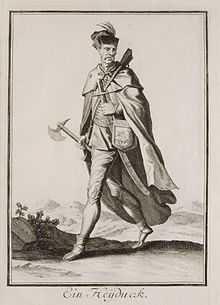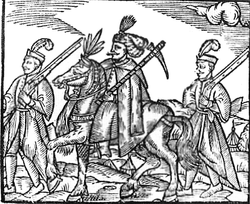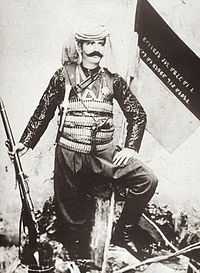Hajduk

Hajduk (or ajduk, haydut, haiduk, haiduc, hayduck, hayduk) is a term most commonly referring to outlaws, highwaymen or freedom fighters in Southeastern Europe, Central and Eastern Europe.
In Balkan folkloric tradition, the hajduk (hajduci or haiduci in the plural) is a romanticised hero figure who steals from, and leads his fighters into battle against, the Ottoman or Habsburg authorities. They are comparable to the English legend of Robin Hood and his merry men, who stole from the rich (which as in the case of the hajduci happened to be also foreign occupants) and gave to the poor, while defying unjust laws and authority.
In reality, the hajduci of the 17th, 18th and 19th centuries commonly were as much guerrilla fighters against the Ottoman rule as they were bandits and highwaymen who preyed not only on Ottomans and their local representatives, but also on local merchants and travelers. As such, the term could also refer to any robber and carry a negative connotation.[1][2]
Etymology
The etymology of the word "hajduk" is unclear. One theory is that hajduk was derived from the Turkish word haidut or haydut, which was originally used by the Ottomans to refer to Hungarian infantry soldiers. Another theory suggests that the word comes from the Hungarian hajtó or "hajdó" (plural hajtók or "hajdók"), meaning a (cattle) drover.[3] Indeed, these two theories do not necessarily contradict each other, as the Balkan word is said to be derived from the Turkish word haiduk or hayduk (bandit),[1][2][4] while the Turkish is in turn believed to have been borrowed from Hungarian and to have originally referred to Hungarian mercenaries who guarded the Hungarian-Turkish border.[5]
Forms of the word in various languages include:
- hajdut (Albanian); in the ordinary sense of "thief"
- հայդուկ (hayduk) (Armenian) - used as a male given name
- hajduk (Bosnian)
- хайдут, хайдутин or хайдук (haydut, haydutin, hayduk) (Bulgarian)
- hajduk (Croatian)
- haïdouk (French)
- aiducco (Italian)
- hajdú sing. hajdúk pl. (Hungarian)
- ајдук (ajduk), ајдутин (ajdutin) (Macedonian)
- hajduk (Polish)
- haiduque (Portuguese)
- haiduc (Romanian)
- хајдук/hajduk (Serbian), meaning sometimes "policeman" in older usage
- hejduk (Swedish)
- haydut (Turkish); in the ordinary sense of "bandit"
- hejduk (Kurdish)
- гайдук (gajduk) (Russian)
- гайдамака (haydamaka) (Ukrainian)
- הײַדאַמאַק (haydamak) (Yiddish)
Hungary
In 1604-1606, István Bocskay, Lord of Bihar, led an insurrection against the Habsburg Emperor, whose army had recently occupied Transylvania and begun a reign of terror. The bulk of Bocskay's army was composed of serfs who had either fled from the war and the Habsburg drive toward Catholic conversion, or been discharged from the Imperial Army. These peasants, freelance soldiers, were known as the hajduk. As a reward for their service, Bocskay emancipated the hajduk from the jurisdiction of their lords, granted them land, and guaranteed them rights to own property and to personal freedom. The emancipated hajduk constituted a new "warrior estate" within Hungarian feudal society. Many of the settlements created at this time still bear the prefix Hajdú such as Hajdúbagos, Hajdúböszörmény, Hajdúdorog, Hajdúhadház, Hajdúnánás, Hajdúsámson, Hajdúszoboszló, Hajdúszovát, Hajdúvid etc., and the whole area is called Hajdúság (Land of the Hajduk) (see Hajdú County).
Polish-Lithuanian Commonwealth

The word hajduk entered the Polish language from Hungarian in the late 16th century.[citation needed] It was initially a colloquial term for a style of footsoldier, Hungarian or Turco-Balkan in inspiration, that formed the backbone of the Polish infantry arm from the 1570s until about the 1630s. Unusually for this period, Polish-Lithuanian hajduks wore uniforms, typically of grey-blue woolen cloth, with red collar and cuffs. Their principal weapon was a small calibre matchlock firearm, known as an arquebus. For close combat they also carried a heavy variety of sabre, capable of hacking off the heads of enemy pikes and polearms. Contrary to popular opinion, the small axe they often wore tucked in their belt (not to be confused with the huge half-moon shaped berdysz axe, which was seldom carried by hajduks) was not a combat weapon, but rather was intended for cutting wood.
In the mid 17th century hajduk-style infantry largely fell out of fashion in Poland-Lithuania, and were replaced by musket-armed infantry of Western style. However, commanders or hetmans of the Polish-Lithuanian Commonwealth continued to maintain their own liveried bodyguards of hajduks, well into the 18th century as something of a throwback to the past, even though they were now rarely used as field troops. In imitation of these bodyguards, in the 18th century wealthy members of the szlachta hired liveried domestic servants who they called hajduks, thereby creating the meaning of the term 'hajduk' as it is generally understood in modern Polish.[6]
Cultural influence
The Croatian football team HNK Hajduk Split; Serbian football teams Hajduk Kula, FK Hajduk Beograd, FK Hajduk Veljko and Hajduk Lion; the Macedonian football team FK Hajduk - Vratnica; the pop-music project Haiducii, and Romanian Romani musical troupe Taraful Haiducilor are all named after the hajduci. The surnames of the fictional character George Washington Hayduke, invented by Edward Abbey, actress Stacy Haiduk, US national soccer team defender Frankie Hejduk and Czech Republic national ice hockey team forward Milan Hejduk, are likewise derived from this word.
The term "haiduci" was used by the Romanian resistance movement Haiducii Muscelului, between 1947 and 1959, which opposed the Soviet occupation and the Communist government.
In academics
In the early 1970s, after the publication of the now classic sociological studies Primitive Rebels and Bandits by historian Eric Hobsbawm, hajduks started appearing in western social and anthropological literature. Hobsbawm invented the term "social bandit" to describe outlaws who operate on the edges of rural societies by fighting against authorities and sometimes helping the ordinary people. There has always been a degree of fluidity in their status, whereby, as described by John Koliopoulos in his study of Greek klephts, Brigands with a Cause, brigands would sometimes change sides and start acting on behalf of the authorities to preserve peace and suppress banditry, and vice-versa.
From the early 1980s, sociological studies started narrating the stories of hajduks, klephts, bandits, brigands, outlaws, rebels, and pirates in all parts of the planet, from Australia to republican China, the Balkans, the American Wild West, Cuba and Mexico.
Notable hajduks
Albanian
- Çerçiz Topulli
- Sulejman Vokshi
- Bajo Topulli
- Mihal Grameno
- Idriz Seferi
- Themistokli Germenji
- Isa Boletini
- Ded Gjo Luli
- Baca Kurti Gjokaj
- Pretash Zeka Ulaj
- Azem Galica
- Shote Galica
Armenian

- Andranik Ozanian
- Arabo
- Dro
- Garegin Nzhdeh
- Monte Melkonian
- Serob Aghpur
Bulgarian

- Delyo
- Chavdar Voyvoda
- Indzhe Voyvoda
- Ilyo Voyvoda
- Angel Voyvoda
- Captain Petko Voyvoda
- Panayot Hitov
- Filip Totyu
- Hadzhi Dimitar
- Stefan Karadzha
- Karposh [7]
Croatian
- Ivo Senjanin
 Harambaša was a senior commander of a hajduk band from Dalmatia in the 19th century.
Harambaša was a senior commander of a hajduk band from Dalmatia in the 19th century. - Mijat Tomić
- Andrijica Šimić
- Ivan Bušić Roša
- Petar Mrkonjić
- Elia Peraizza
- Stanislav Sočivica
- Ivan Rošo Bušić [8]
Romanian
- Baba Novac/Starina Novak(second half of the 16th century), of half-Serbian, half Romanian origin, captain in prince Michael the Brave's army in Transylvania
- Iancu Jianu (early 19th century) from Oltenia region, befriended and fought together with freedom fighter Tudor Vladimirescu in the emancipation Revolution of 1821
- Radu Şapcă, priest and hajduk in the first half of the 19th century from the region of Oltenia, he supported the liberal revolutionaries of 1848 in Wallachia and helped organized the Islaz Assembly
Serbian
- Mali Radojica, outlaw from epic poetry, in Dalmatia
- Bajo Pivljanin, famous hajduk from Herzegovina
- Petar Popović Pecija, a "voivode" of two major anti-Ottoman uprisings.
- Jovan Nenad, rebel against the Hungarian rule in South Hungary
- Radoslav Čelnik, Jovan Nenad's subcommander, liberator of Syrmia
- Starina Novak, ally of Michael the BraveStanislav Sočivica, Croatian hajduk (highway robber and freedom fighter), 18th century
- Stanoje Glavaš, voivode in the First Serbian Uprising
- Stojan Čupić, voivode in the First Serbian Uprising
- Hajduk Veljko, voivode in the First Serbian Uprising
- Čučuk Stana, wife of Hajduk Veljko
- Jovo Stanisavljević Čaruga, Slavonian outlaw
Greek
- Theodoros Kolokotronis
- Geórgios Karaïskákis
- Markos Botsaris
- Athanasios Diakos
- Nikitaras
- Odysseas Androutsos
- Antonis Katsantonis
Hungarian
- Bandi Angyal
- Jóska Sobri
- Sándor Rózsa
Ukrainian
Slovak
See also
- Bushrangers of Australia
- Fedayee
- Haidamaka
- Hajduk (soldiers)
- Hajduk Split, Croatian football club
- Hayduke
- Klepht
- Armatoloi
- Rapparee
- Uskoks
- Ayyarun
- Zeibeks
- Hajdučka Republika Mijata Tomića, a micronation
- Tadas Blinda, a similar figure in Lithuania
References
- ↑ 1.0 1.1 Найден Геров. 1895-1904. Речник на блъгарский язик.Хайдукъ
- ↑ 2.0 2.1 Л.Андрейчин и др. 2006. Български тълковен речник. Четвърто издание
- ↑ Petrović, Aleksandar. These persons become later soldires at the Hungarian-Turkish border and fight against the Otoman Turkish. The Role of Banditry in the Creation of National States in the Central Balkans During the 19th Century
- ↑ Младенов, Стефан. 1941. Етимологически и правописен речник на българския книжовен език
- ↑ Max Vasmer's Etymological Dictionary of Russian (Russian)
- ↑ Richard Brzezinski, Polish Armies 1569-1696, volume 1, London: Osprey Military Publishing, 1987, p. 21, 39-41 (also contains six contemporary illustrations of Polish hajduks, besides several modern reconstructions by Angus McBride).
- ↑ "Karposh's Rebellion - Wikipedia, the free encyclopedia". En.wikipedia.org. 2013-07-13. Retrieved 2014-01-03.
- ↑ "Ivan Rošo Bušić - Wikipedija" (in (Croatian)). Hr.wikipedia.org. Retrieved 2014-01-03.
External links
| Wikisource has the text of the 1911 Encyclopædia Britannica article Haiduk. |
